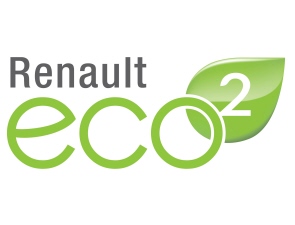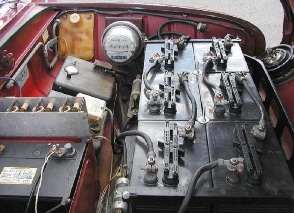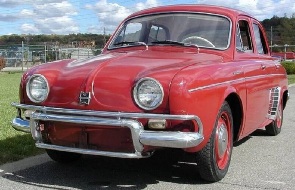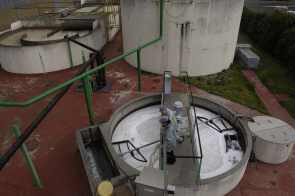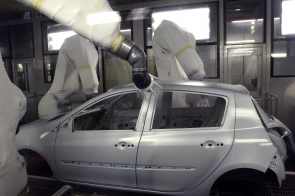Renaults vision towards
ZE, the
environment and living & work environment
Project Oxygen
Renault Trucks geeft
vervolg aan zijn onderzoeks- en ontwikkelingswerkzaamheden met
het prototype Oxygen. Terwijl een eerste testfase in Lyon en
Parijs nog loopt, gaat de fabrikant een nieuwe test uitvoeren
met een tweede versie van deze elektrische truck voor
stadslogistiek. In oktober 2024 zal in Amsterdam een versie met
koelunit worden getest, die is ontworpen met steun van Renault
Trucks Nederland en in samenwerking met supermarktketen Jumbo en
SVZ.
|
 |
| |
2024 Project Oxygen |
Ampere
 |
|
Ampere is door Renault
Group opgericht om de uitdagingen aan te gaan en te
profiteren van de kansen die voortvloeien uit de
transformatie van de auto-industrie, en tegelijkertijd het
hoofd te bieden aan de klimaatproblemen. Het doel is om met
Ampere uit te groeien tot Europees leider in de sterk
groeiende markt van elektrische voertuigen. Ampere wordt
gedreven door technologie en ontwikkelt een horizontaal
model om extra wendbaar te zijn en sneller te kunnen
innoveren. Het doel is om elektrische voertuigen in Europa
te democratiseren, met voertuigen die mensen zich kunnen
veroorloven. Ampere vertrouwt op vijftien jaar expertise met
elektrische modellen en combineert een wendbare en
efficiënte organisatie om volledig elektrische auto’s voor
de Europese markt te ontwerpen en een unieke klantervaring
te bieden.
Ampere is opgericht met
een routekaart om ESG (Environmental, Social & Governance)
te integreren in de complete waardeketen – van de producten
en diensten die het bedrijf ontwikkelt tot de processen,
waardoor een koolstofarme circulaire economie ontstaat. Het
industriële en technologische project dat Ampere nastreeft,
vindt sterke weerklank op de Europese markt waar Renault
Group is ontstaan. Het beschikt over een uniek reeks
vaardigheden en een solide industrieel en technologisch
ecosysteem dat de gehele waardeketen beschermt. Ampere
exploiteert elf locaties in Frankrijk, waaronder vier
industriële faciliteiten: de fabriek in Cléon en de
ElectriCity-faciliteit met fabrieken in Douai, Maubeuge en
Ruitz. |
| |
|
Het bedrijf telt ruim
11.000 medewerkers (waarvan 35% ingenieurs) die
hoogwaardige, veilige en duurzame voertuigen ontwerpen,
ontwikkelen, produceren en op de markt brengen onder het
merk Renault. Samen bundelen zij hun krachten om deze
grootschalige transitie naar elektrische mobiliteit tot
stand te brengen. |
Hydrogen
Renault met Hyvia in
realistisch waterstofproject (Bron: Bestelauto, 19-10-2021).
Renault is in zee gegaan
met Hyvia en Plugpowers. Dat zijn twee vooraanstaande bedrijven
in de waterstofwereld. Samen hebben ze een naar wat het lijkt,
zeer realistisch project ontwikkeld om bedrijfswagens op zowel
batterijen als waterstof te laten rijden. De productie start
eind dit jaar in Frankrijk. Bestelauto sprak met Hyvia CEO David
Holderbach.
|
 |
 |
“Wat wij willen is meerledig”,
vertelt Holderbach. “Wij willen een zero-emissie transportoplossing die
rijdt zonder concessies. En we willen de energietransitie voor bedrijven
eenvoudiger maken. Dat kan door zelf waterstof te produceren ten behoeve
van hun eigen vloot. Dat garandeert de aanwezigheid van steeds voldoende
schone energie en voorkomt overbelasting van het net. Want ons systeem
draagt ook bij aan de demping van de steeds sterkere pieken in de
productie van elektriciteit door wind en zonnepanelen enerzijds en
teveel vraag aan de andere kant. Maar ook bedrijven die niet over de
mogelijkheid beschikken zelf energie op te wekken, kunnen met ingekochte
groene stroom of certificaten met ons systeem op waterstof rijden.”
De totaaloplossing, zelf waterstof
maken, bufferen en in de eigen vloot gebruiken is niet nieuw. Maar wat
Renault nu aanbiedt, is wel een oplossing met één telefoonnummer. En
daar houden ondernemers van. Hyvia heeft op basis van de vernieuwde
Renault E-Master twee auto’s ontwikkeld. Een voor personenvervoer en een
bestelauto. Beide beschikken naast de normale elektrische set up, ook
een brandstofcel en opslagtanks voor waterstof. Daarmee gaat niet alleen
de actieradius van het voertuig omhoog van 200 naar 500 kilometer. Ook
kun je binnen vijf minuten weer 300 kilometer rijden door eenvoudigweg
te waterstof te tanken. Dat verhoogt de inzetbaarheid van de voertuigen
aanzienlijk.
En daarin schuilt de flexibiliteit
van het systeem. Natuurlijk kun je voor het geld die de waterstofversie
van de Master kost, ook een bestelwagen neerzetten met voldoende
batterijcapaciteit om 500 kilometer te kunnen rijden. Dat kon wel eens
lichter zijn ook want de gewichtspenalty van de elektrisch aangedreven
E-master met fuelcell is 450 kilogram. “Maar grotere batterijen
betekenen ook langer laden of DC-snelladen. Met als gevolg dat de zware
wissel die dat trekt op de stroominfrastructuur dat vaak onmogelijk
maakt. En het extra gewicht wordt (voorlopig) gecompenseerd in de
toelating zodat het originele laadvermogen van de Master behouden
blijft”, weet Holderbach.
|
 |
 |
Het Renault Hyvia systeem dat
Renault begin volgend jaar gaat uitrollen, betekent volgens de CEO
meteen ook een kostenslag en een veel betere TCO. “Het is bijzonder
geschikt voor bedrijven die nu al zelf energie opwekken. Die kunnen daar
een veel beter rendement op gaan behalen.” Daar heeft Holderbach een
punt. Elke firma met een veldje zonnepanelen op hun gebouw of wellicht
zelfs een windmolen, weet dat een groot deel van die energie overdag
tegen een lage vergoeding in de grid verdwijnt. Tegelijkertijd moet men
‘s ‘nachts dure energie terugkopen om de elektrische voertuigen op te
laden. Want die werken doorgaans overdag.
Renault en Hyvia gaan die cyclus
omdraaien door overdag van de overtollige zonne-energie waterstof te
maken met een compacte electrolizer. Daardoor kan een bedrijf zijn
opgewekte zonne- of windenergie veel hoger in de keten wegzetten.
Namelijk op het niveau van automotive brandstof. Dat maakt voor hem het
rijden een stuk goedkoper. Tegelijkertijd belast hij de grid veel minder
omdat hij nagenoeg niets teruglevert.
De Elektrolyser zelf werkt volgens
het PEM systeem. Dat staat voor Polymere Exchange Membrame. Daarbij
wordt het water langs talloze platen met om en om een anode en een
kathode geleidt met daartussen een membraam dat ondermeer voor de
scheiding van de gassen (H en O2) zorgt. De elektrolyser van Hyvia is
state of the art. Op zich bestaat de PEM techniek al sinds de jaren 60
en is daarmee proven technology. Bovendien is er buiten het laboratorium
om niets dat efficiënter is en volledig commercieel kan worden ingezet.
Hyvia ontwikkelde ook de opslag op
700 bar, de pomp als wel de techniek in de Renault Master H2-Tech zelf.
Zo ontstaat als het ware een eigen eco-systeem: Een bedrijf maakt
optimaal gebruik van de zelf opgewekte energie, slaat het surplus op in
waterstof ten behoeve van de eigen vloot. Met één pomp kan men tot 12
auto per uur voltanken. Dat is voorlopig meer dan voldoende.
|
 |
 |
De Renault Master zelf blijft
ondanks zijn hoge hoed waaronder zowel de fuelcell als de tanks zijn
onder gebracht volledig functioneel. De originele laadruimte van 12m3
blijft intact. De actieradius van 500 kilometer komt door de 30 kW
brandstofcel in combinatie met een 33 kW batterij. Dat is een iets
kleiner batterijpakket dan in de nieuwe elektrische Renault Master. De
elektromotor en verdere elektronica blijft hetzelfde. Het op 700 bar
gecomprimeerde waterstofgas zit in vier tanks op het dak met in totaal
zes kilo inhoud. Fuelcell en batterij werken nauw samen. De stroom uit
de brandstofcel is om te rijden én de batterij te laden. Normaal rijdt
de auto op de elektrische energie die de brandstofcel levert. Cruisend
op dezelfde snelheid regelt de computer het bijladen van de batterij met
de overcapaciteit van de fuelcell. Maar bij het accelereren of
wegtrekken, pakt de elektromotor even energie uit de batterij bij.
Daardoor kan de brandstofcel binnen een nauwe bandbreedte op steeds
dezelfde belastinggraad werken. Dat komt zowel de levensduur als de
efficiëntie ten goede. De remenergie wordt geregenereerd en vloeit terug
in de batterij. Later volgend jaar volgt er ook nog een Renault Master
op waterstof als chassis cabine met 19m3 laadruimte. Die zal echter een
actieradius van 250 kilometer krijgen.
2021 Renaulution
24 nieuwe
modellen tot 2025 waarvan 10 electrisch en een nieuwe focus.
Groupe
Renault maakt zich klaar voor de toekomst en presenteert een
nieuwe strategie die uit drie fasen bestaat. Tot en met 2025
presenteren de merken van Groupe Renault maar liefst 25 nieuwe
producten, waarvan zich de helft in het Mégane- en
Talisman-segment bevindt. Een groot deel van de nieuwkomers is
volledig elektrisch.

Renaulution. Dat is de naam van de strategie die Groupe Renault de
komende jaren gaat uitzetten.traks is er éen modulaire
benzinemotorenfamilie waar ook mild-hybriden, hybriden en plug-ins onder
vallen. Daarnaast komt er alleen nog voor bedrijfswagens een
dieselmotorenlijn. Er komen twee families elektromotoren- en
brandstofcellen, verdeeld in lage en midden/hoge vermogens. Ook wordt
het algehele vermogensbereik vergroot. Waar Groupe Renault nu motoren
bouwt met vermogens tussen de 60 en 300 pk, wordt dat bereik vergroot
van 45 tot 400 pk.
In totaal komen er zes nieuwe
bedrijfswagens waarvan er drie volledig elektrisch zijn. Er komt een
elektrische nieuwe A-segmenter, twee elektrische nieuwe B-segmenters en
twee geëlektrificeerde B-segmenters. Ook komt er een niet
geëlektrificeerd nieuw model in het B-segment. In totaal lanceert Groupe
Renault zeven nieuwe C-segmenters. Drie daarvan zijn volledig
elektrisch, drie zijn geëlektrificeerd en één ervan is puur en alleen
met benzinemotoren te krijgen. In het D- en 'sportsegment' komen vijf
nieuwe modellen waarvan er drie elektrisch en twee geëlektrificeerd
zijn.
Renault wordt binnen Groupe Renault de grote speler op EV-gebied. Het
merk moet de 'groenste' line-up van Europa krijgen. De helft van de op
stapel staande nieuwkomers van Renault wordt een EV. Daarnaast mikt het
merk erop dat 35 procent van zijn verkopen uit hybriden en plug-in
hybriden zal bestaan en dat 30 procent volledig elektrisch zal zijn. Ook
gaat Renault meer aandacht aan brandstofceltechniek besteden, onder meer
door een joint-venture aan te gaan.
2020 E-tech & ZE-range

Automatisch (autonoom) rijden
EZ-PRO, de robotauto die bezorgen in de stad gaat
veranderen.
De EZ-PRO Concept verandert autonoom rijden in de stad, met gedeelde en
verbonden mobiliteit ... klaar voor de bezorgingsuitdagingen van de
toekomst.
Anticiperend op de toekomst van
bezorgdiensten.
De EZ-PRO Concept is ontwikkeld met hetzelfde platform als de
EZ-GO en is bedoeld voor transport en het leveren van pakketten en
diensten in de stad (afgestemd op het last-mile ecosysteem).
De EZ-PRO Concept wordt gebruikt door één of meerdere
pakketbezorgingsdiensten en is ideaal om te voldoen aan de behoeften van
bedrijven en klanten. De auto levert het bestelde item veilig op de
gewenste locatie van de klant af, bijvoorbeeld in een kluisje dat kan
worden ontgrendeld met een smartphonetoepassing.
De EZ-PRO Concept past zich uitstekend aan in de stad en laat het
verkeer vloeiend doorlopen. De auto houdt rekening met andere
bestuurders, is stil en vervuilt niet: een positieve invloed op de stad!
Speciaal afgestemd op praktische vereisten.
De EZ-PRO Concept is gebaseerd op het Easy Life-concept van
Renault. De auto rijdt autonoom en heeft een verbonden en gedeeld
platform. Het voertuig bestaat uit twee elementen, ook wel 'pods'
genoemd. Om toe te zien op de bezorging, zit in de voorste pod een
medewerker. De volgende pod of pods volgen, of rijden onafhankelijk door
naar het bezorgingspunt.
 |
 |
|
EZ-PRO |
EZ-GO |
Net als bij de EZ-GO-conceptcar is er voorin een grote opening en
is er een uitklapbaar trapje ingebouwd zodat werknemers eenvoudig kunnen
in- en uitstappen. Het platform is praktisch en functioneel en uitgerust
met schuifdeuren die naar boven openen. Er verschijnt ook automatisch
een oprijplank voor eenvoudige toegang tot de laadruimte.
Ontwikkeld op basis van de behoeften van de medewerker.
De cockpit van de leidende pod is het werkgebied van de
medewerker. Het ontwerp is eenvoudig, ergonomisch en efficiënt. Alle
overbodige zaken zijn verwijderd, zodat alleen de essentiële zaken
beschikbaar zijn.
Het platform biedt veel comfort en is praktisch. Het biedt
functies voor automatisch rijden zodat de medewerker de leveringen kan
instellen en zich vervolgens kan richten op de afhandeling van de
levering, waarmee het menselijke aspect behouden blijft. De aanpasbare
cabine kan ook worden gebruikt als mobiel kantoor (in de zijwaartse
positie), of kan worden gebruikt om mee te kijken op de weg (naar voren
gericht).
Henney Kilowatt Dauphine
The Henney Kilowatt made its fleeting appearance in 1959 in the United
States, an American electric Dauphine designed by the National Union
Electric Corporation and Eureka Williams. At this time in history
electric vehicles were pretty much unheard of, so this was a wild
project involving huge challenges!
Birth of the
electric Dauphine project.
In the late
nineteen-fifties and early sixties, Renault was gradually withdrawing
from the US market, after experiencing mixed results there. But around
the same period the Renault Dauphine was attracting interest for what
was at the time a rather unusual reason: electric power. In 1959,
Russell Feldman, president of the National Union Electric Corporation,
owner of the Henney coachwork firm, and battery producer for Exide
Batteries, asked Renault to deliver 100 Dauphines without powertrains.
The Dauphine was chosen, obviously because Renault had some remaining
stock in the US but also for two important reasons: it was much lighter
than other cars on the market, and the rear-mounted engine compartment
was ideal for fitting an electric motor, usually a General Electric
unit, found in Fenwicks. The Henney Kilowatt, as it was known, would
bring in orders from a grand total of 47 customers, well in advance of
the rest of the world as regards environmental awareness.
 |
|
Most of the
electric cars (32) went to electric utility companies, but motorists
could buy them directly from Henney too. Which was the case of the State
of Tennessee authorities, who ordered electric Dauphines for use as a
service vehicle. We know of only 2 of these cars in roadworthy condition
today. There are a dozen or so, in various states of repair, in the US
and 2 in France (including one owned by Renault Classic).
|
A 75 KM range
and 14 6 V batteries
Henney's
Dauphine Kilowatt existed in two versions: the first, intended for urban
use, was powered by 12 6 V batteries wired in series, and achieved a top
speed of 64 km/h and a full-charge range estimated at 64 km. Only 8 of
these cars were made. The second, powered by 14 6 V batteries, raised
the top speed to 80 km/h and the range to 75 km. Electrical systems took
up a great deal of space on the car, and the Henney Kilowatt did not
have a boot. Even so, the vehicle weighed in at 950 kg to 1100 kg
depending on the version. Both models were available in a choice of
three colours: red, grey or black.
How Renault
Zoe was inspired by this American electric Dauphine
Electric
vehicle technology has come a very long way since then! But, sure, the
evolutionary traces are there if we look for them. For a start, we have
braking energy recovery: on a more advanced version developed a few
years later by Bell Laboratories, we find partial battery recharge
during braking, plus onboard electronic control.
A second
point in common is the somewhat similar business model. Because of the
high battery price, Yardney (who also developed an electric Dauphine)
planned to lease them rather than sell them, and thus make the car more
affordable. But the project was too far ahead of its time to survive.
Unfortunately, all the early attempts to introduce electric-powered
vehicles ran into the same sort of obstacles we find today, specifically
the lack of widely available charging structures.
We'd like to thank Jean-Jacques Dupuis of
Gazoline
magazine for his article on the subject and his precious help to us in
preparing this blog article.
Electrical
commercial vehicles ZE (Zero Emission)
After ten years of experimentation under actual operating conditions
with its customer-partners, Renault Trucks is pleased to unveil its
second generation of all-electric vehicles: the Renault Master Z.E.,
Renault Trucks D Z.E. and Renault Trucks D Wide Z.E., a complete range
from 3.1 to 26 tonnes ideally suited for use in the city. The Renault
Trucks D and Renault Trucks D Wide Z.E. will be manufactured in the
Renault Trucks plant at Blainville-sur-Orne and will arrive on the
market in 2019. The Renault Master Z.E. will be available in 2018.
To keep pace with the changing face of urban transport, Renault Trucks,
a pioneer in the field of electromobility, is launching its second
generation of electric trucks. The Renault Trucks Z.E. line-up,
consisting of the Renault Master Z.E., Renault Trucks D Z.E. and Renault
Trucks D Wide Z.E., ranging from 3.1 to 26 tonnes, covers the full gamut
of urban uses from goods distribution and delivery to refuse collection.
For Renault Trucks, electromobility was the obvious response to urban
air quality and noise issues from the outset, as well as cut overall CO2
emissions.
For over ten years, the company has been field testing electric trucks
with its customer-partners in order to garner crucial information about
usage, battery behaviour, charging facilities and specific maintenance
requirements.
These real-world tests have also enabled Renault Trucks’
customer-partners to help their own customers come to an acceptance of
electric technology. Renault Trucks has over a decade of experience with
all-electric trucks thanks to the Renault Maxity.
“Ten
years’ ago, we were the pioneers, promoting electric trucks to improve
city air quality”,
explains Renault Trucks President Bruno Blin “Today
we can offer a range of electric vehicles with proven performance and
the experts in our network are ready to help our customers transition to
electromobility. Ten years’ ago we were pioneers, today we are experts.”
The latest technological advances have made electric trucks an
economically viable alternative for hauliers, leading Renault Trucks to
launch a complete Z.E. range.
However strict the regulations may be in urban zones, the vehicles in
the Renault Trucks Z.E. operate seamlessly in compliance. They are the
perfect solution to safeguard air quality and reduce congestion as they
allow noise-free out-of-hours deliveries and emit neither local
pollutants nor CO2.
Some prominent names in freight haulage have already opted for
electromobility. One such company is XPO Logistics “At
XPO, we have led by example as the transport industry becomes
increasingly aware of the need for alternative power”,
said Luis Gomez, managing director-transport, XPO Logistics Europe. “We
commend our supplier Renault Trucks for investing in the development of
electric vehicles that offer a practical way to achieve zero emissions*.
Renault Trucks is shaping the future of commercial transport in an
evolving regulatory environment.”
Suez is also following the release of the Renault Trucks Z.E range with
interest. “We
are delighted to see a competitive new industrial solution arrive on the
market and to be able to partner with Renault Trucks,”
explains Edouard Hénaut, executive director local authorities services
at Suez. “This
new electric truck offering will allow Suez to help its customers reduce
their carbon footprint thanks to a zero-emission
environmentally-friendly and silent refuse collection solution.”
The Renault Master Z.E., which will be released in September 2018, is
ideal for last-mile deliveries and provides access to inner-city areas
even those with strict traffic restrictions. The battery of this
all-electric utility vehicle takes six hours to charge.
Its loading volume is the same as a conventional diesel Renault Master
as the batteries are mounted under the front seats. The Master Z.E.
range comes in six variants (four panel vans and two platform cabs)
designed to meet all the requirements of professionals working in urban
environments.
 |
 |
 |
 |
|
2016 Master ZE |
2017 Kangoo ZE |
2018 D ZE |
2018 D-wide ZE |
 |
 |
 |
 |
|
2020 Kangoo ZE |
2021 D-wide ZE Low Entry Cab (LEC) |
2023 E-tech T |
2023 E-tech C |
 |
 |
 |
 |
|
2023 D-serie E-tech |
2023 Master E-tech |
2024 Project Oxygen |
2024 D Wide E-Tech Low Entry |
Lastly, to protect the driver and the load and keep city-dwellers safe,
the Master Z.E. is outfitted with a reversing camera, reversing radar
system and wide-view mirror as standard features.
The specially designed 16 t version of the Renault Trucks D Z.E. is
ideal for urban and controlled temperature deliveries. The Renault
Trucks D Wide Z.E. will come in a 26 t version for efficient refuse
collection. Both models will be manufactured at the Renault Trucks plant
in Blainville-sur-Orne, Normandy, France in the second half of 2019.
A medium-duty Renault Trucks Z.E. vehicle has an operating range of up
to 300 km depending on usage and battery configuration. The battery pack
is the most expensive item when buying an electric truck. For Renault
Trucks, there is no question of compromising on payload or
cost-effectiveness, so different operating ranges will be available
tailored to customers’ exact needs.
Thanks to rapid DC charging, the Renault Trucks D Z.E. and Renault
Trucks D Wide Z.E. lithium-ion batteries can be fully charged in as
little as one to two hours via the 150 kW Combo CCS connector. For
overnight AC charging, the time to fully charge a 300-kWh battery is 12
hours. In this case, a three-phase 380V 32A industrial power socket is
perfectly sufficient.
For maximum flexibility in terms of usage and bodywork, the Renault
Trucks D Z.E. and Renault Trucks D Wide Z.E. are equipped with a power
take-off and a standard mechanical interface.
Electrische auto's ZE (Zero Emission)
Renault is in Europa marktleider met
zijn uitgebreide gamma elektrische
auto's. Sinds de introductie van de
eerste elektrisch aangedreven Renault –
de Kangoo Z.E. – eind 2011, verkocht
Renault al zo'n 30.000 exemplaren in
Europa en is daarmee marktleider. Het
Zero Emission-gamma van Renault bestaat
uit de Kangoo Z.E., de ZOE en de Twizy.
Renault blijft ook in de toekomst
inzetten op emissievrije auto's.
The electric vehicle:
good sense for the environment.
“Electric vehicles form
the only practical and affordable solution in existence today to our
planet’s transport-related environmental challenges.”
CARLOS GHOSN, President and CEO of
Groupe Renault
A pioneering
strategy:
Wide-scale rollout of
all-electric vehicles.
Renault
has a long record of commitment to
sustainable transport for all.
For more than twenty years the company has been consistently endeavouring to
reduce the environmental impact of its vehicles and business activities.
Renault was the first European
automaker to believe in the all-electric vehicle.
The all-electric
vehicle is the flagship of Renault’s environmental commitment.
In 2009,
Carlos Ghosn announced a strategy, ambitious and completely unique in the
automotive industry, that would involve putting a full range of affordable
all-electric vehicles on the market by 2012. Renault was true to its word.
Groupe
Renault today offers electric vehicles addressing a broad spectrum of the
population: Fluence,
ZOE, Kangoo Z.E., Twizy RSM SM3 Z.E
and Master.
 |
 |
 |
 |
|
2010 Fluence ZE |
2012 Twizy ZE |
2013 Zoe ZE |
2013 Kangoo ZE |
 |
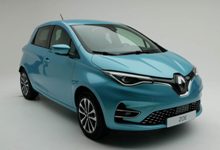 |
 |
 |
|
2013 Samsung SM3 ZE |
2019 Zoe |
2020 Twingo Electrique |
2021 Mégane Electric |
 |
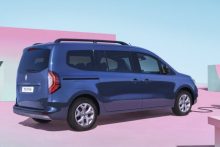 |
 |
 |
|
2022 Kangoo E-Tech Electric |
2023 Grand Kangoo E-Tech Electric |
2024 5 E-Tech Electric |
2024 4 E-Tech Electric |
Renault
ranks
number-one for electric vehicle sales in
Europe. In
2016, more than one electric vehicle in four is a Renault. And the market is
on the rise. ZOE is Europe’s biggest selling electric vehicle, and Kangoo Z.E.
leads the European market for electric light commercial vehicles.
Zero-pollution
motoring, for more breathable air.
Because they emit no
exhaust pollutants (particulates, nitrogen oxides, etc.) when driven,
electric vehicles have a key role to play in improving air quality, with the
attendant benefits to public health, especially in urban areas.
Studies have shown that
a 20% proportion of electric vehicles in city centres would bring a
reduction of up to 30% in the concentration of particulates and of up to 45%
in the concentration of nitrogen dioxide. These reductions
become especially important under peak pedestrian exposure conditions, when
pollutant levels rise as a result of meteorological conditions unfavourable
to pollutant dispersion.
Zero-CO2
driving,
an effective countermeasure
against climate change.
Electric
power is the real
breakthrough solution for countering climate change, because electric cars
emit no CO2 (carbon
dioxide) while driving(1).
Because an electric motor does not burn any fossil fuel, Renault is fully
committed to the electric vehicle as the innovative solution capable of
meeting today’s environmental challenges.
Even when we factor in CO2 emissions produced by generating the
electricity needed to charge an electric vehicle, the carbon balance is much
better than for an equivalent internal-combustion model in most of the
countries where electric vehicles are sold.
In Europe, the overall carbon figure averages around 72 grams of CO2
per km for ZOE, compared to at least 100 grams for an equivalent
internal-combustion model.
The overall carbon footprint of an electric vehicle varies from one country
to another, with the degree of carbon dependency of local power plants. In
France, for example, where power-plant carbon dependency is relatively low,
the carbon footprint of the Renault ZOE is about 14 grams of CO2
per km.
Heading for zero
CO2,
electricity generation included Stepping up
the energy transition.
Electric vehicles
contribute to the energy transition in the automotive industry by
reducing the use of fossil energies
(traditional fuels) for transport needs. According to the International
Energy Agency, with seven million electric vehicles on the road worldwide,
we would save 400,000 barrels of crude oil per day from now through to 2020.
And Renault electric vehicle can also contribute to the energy transition in
any other business sector than consumes electricity.
Renault is a
partner on various projects to develop technical solutions in the production
of “green” (i.e. low-carbon) electricity, the aim being to reduce depletion
of the planet’s natural resources. These solutions primarily seek to
compensate for the inherently intermittent nature of renewable energy
sources (solar, wind, etc.), this being the main impediment to development
of green electricity production today.
Renault
electric vehicles in car-share schemes
worldwide.
As well as
enjoying an environmentally sound transport practice, Renault electric
vehicle drivers also appreciate the unique driving sensations and superior
convenience of electric power.
Peace and quiet driving becomes much
less stressful without engine noise and vibration. Smooth,
crisp response. Acceleration is smooth,
perfectly linear and sprightly from low revs. In-home
charging station.
When buying a Renault
electric vehicle, the customer gets full advice on the main charging station
for it (at the driver’s home or workplace, or a nearby street location).
Charging infrastructure
on the increase.
The electric vehicle
charging infrastructure has been growing at a rate of 30% to 60% per year
since 2013. There are more than 100,000 stations worldwide and 80,000 in
Europe. By 2017 France will have trebled its charging infrastructure, to
40,000 stations in all.
Development of
fast-charge stations.
At a fast-charge
station, it takes ZOE just 30 minutes to get a 80 to 120 km travel range
boost. There are already around 2,300 fast-charge stations along major trunk
roads in 15 European countries.
Reassuring battery
rental conditions.
Renault’s battery
rental contract guarantees the customer a fully functional battery (at least
75% original charge capacity) at all times, regardless of vehicle age and
mileage. And Renault roadside assistance covers the vehicle even if it just
runs out of charge.
Electric
vehicle privileges.
Electric vehicles enjoy
various privileges in many European cities: special lanes, congestion charge
exemption, in-street charging stations, and special-rate (or free) street
parking.
Competitive running
costs compared to
internal-combustion cars. Electric cars cost less
to run: servicing, insurance, charging, etc.
Electric vehicles for
all
Renault fields a full
range of electric vehicles, addressing a wide customer base with four models
that cover a broad usage spectrum: the ZOE compact city car, the Kangoo Z.E.
van, the Twizy urban quadricycle, and the RSM SM3 Z.E. upmarket sedan.
Purchase prices are comparable to those of equivalent internal-combustion
vehicles, especially in countries that practise tax incentives for electric
vehicles, and running costs are competitive.
Meeting new mobility
needs.
Renault anticipates and
responds to new mobility needs, seizing emerging opportunities for the use
of its all-electric vehicles. Because of increasing urban road congestion,
and for financial reasons, more and more people are giving up car ownership
in favour of car-pooling. Renault actively encourages sharing of its
electric vehicles.
Renault Mobility
In summer 2016 Groupe
Renault launched a new car-sharing service, Renault Mobility, providing both
private users and businesses with round-the-clock self-service access to
both electric and internal-combustion cars (ZOE, Captur, Clio). The service
is currently under trial in France, and Renault plans to develop this kind
of solution in urban and rural areas through its network of partners, with a
view to offering nationwide local access.
Hybrid trucks
Renault Trucks
Hybrys: an
innovative, urban, hybrid technology concept vehicle.
With its futuristic design, Hybrys is an expression
of Renault Trucks’ vision of future urban transport. It is also a
progressive step towards the inclusion of hybrid technologies in its
products already on the market, offering alternative solutions to diesel.
Environmental protection, increasing prices for
petrol-based products and their diminishing resources has driven Renault
Trucks to broaden its product offer for increasingly lower fuel consumption
vehicles by means of new energies.
In its product range, targeting local authorities
and highways agencies, Renault Trucks offers a unique range of engines and
alternative energy solutions : bio-diesel, natural gas, diesel / electric
bi-modal and wholly electric. In the near future, hybrid, so called
‘parallel’ technologies (combining diesel and electric engines delivering
power depending on different power distribution scenarios) used on the
Hybrys concept vehicle will complement the current solutions.
Eco²
Renault launched the Renault
eco² signature in May 2007
to identify its most
ecological and economical
vehicles. The signature
reflects Renault's aim to
inform customers of the
environmental progress it
has made across the vehicle
life cycle in the last 10
years.
Taking
action for the environment
means looking ahead. Renault
will apply stricter
conditions to its eco2 label
to keep pace with the major
progress made by future
generations of vehicles. At
the same time, the
Renault-Nissan Alliance is
aiming for zero emissions:
zero noise – zero pollutant
emissions – zero greenhouse
gases.
Renault eco² vehicles
fulfill three ecological
criteria in production, CO2
emissions and recycling:
|
* |
Renault eco²
vehicles emit
less than 140
g/km of CO2.
Some
Renault eco²
vehicles can run
on biofuels,
made from plant
matter. |
|
* |
Renault eco² vehicles
are produced at
ISO
14001-certified
plants. This
standard rewards
the progress
made by
manufacturing
sites in
reducing water
and energy
consumption and
in cutting waste
production and
atmospheric and
noise emissions. |
|
* |
Renault eco²
vehicles have to
contain at least
5% recycled
plastic. They
are also
designed so that
95% of their
mass can be
recovered at
end-of-life, and
thus begin a
second
existence. |
Door Renault eco² te
introduceren laat Renault
zien al jaren begaan te zijn
met het milieu om op die
manier talrijke invloeden op
het milieu te beperken
gedurende de hele levensduur
van de auto. Renault maakt
bovendien duidelijk dat het
merk deze grote ecologische
uitdagingen aanpakt door
middel van innovatieve
technieken die op zoveel
mogelijk auto’s toegepast
kunnen worden en die
toegankelijk zijn voor de
klant. Renault eco² maakt
voor de klant zichtbaar in
hoeverre Renault begaan is
met de bescherming van het
milieu en bevestigt nog eens
de milieudoelstellingen van
het Renault Contract 2009.
Renault onderscheidt zich
met name van zijn
concurrenten met de
resultaten op het gebied van
recycling. Renault eco²
verandert voortdurend. Zo
worden de criteria voor
Renault eco² de komende
jaren verder aangevuld en
aangescherpt.
Well to wheels
approach

Renault greift damit aktiv
möglichen künftigen gesetzlichen Regelungen voraus, die derzeit
EU-weit diskutiert werden. Der neue Twingo ist in allen
Versionen das erste Modell, das dieses Gütesiegel erhält,
weitere Fahrzeuge werden kurzfristig folgen. Dazu werden der
Clio 1.2 16V TCE 100, der Mégane1.5 dCi 105 FAP, der Mégane 1.6
16V Bioethanol E85 sowie die leichten Nutzfahrzeuge Trafic 2.0
dCi Biodiesel B30 und Master 2.5 dCi Biodiesel B30 gehören.
Große Breitenwirkung im Fokus
Renault verfolgt darüber
hinaus das Ziel, dass die umweltgerechten Fahrzeuge weiter für
breite Käuferschichten bezahlbar bleiben. Vor dem Hintergrund
der angestrebten Breitenwirkung ist hier der ökonomische Faktor
sehr wichtig. Dabei sollen gleichzeitig preisgünstige und
effiziente Lösungen gefunden werden, um auch den Geldbeutel des
Kunden zu schonen. Einer der viel versprechenden Ansätze, um die
Emissionen zu verringern, ist das so genannte „Downsizing” bei
konventionellen Verbrennungsmotoren: Motoren mit weniger Hubraum
oder Zylindern produzieren geringere Reibungsverluste, was zu
einem günstigeren Wirkungsgrad führt. Bei gleicher Leistung
sinkt der Kraftstoffverbrauch und damit auch das
Emissionsvolumen um 15 bis 20 Prozent. Aktuelles Beispiel ist
der neue Vierzylinder-Benzinmotor 1,2-Liter-16V-TCE mit 74
kW/100 PS. Er leistet so viel wie ein 1,4-Liter-Motor und bietet
mit 145 Nm das Drehmoment einer 1,6-Liter-Maschine. Trotzdem
benötigt das Triebwerk in den Kompaktmodellen Modus und Clio
lediglich 5,9 Liter Superbenzin pro 100 Kilometer, was einem
CO2-Ausstoß von 139 Gramm je Kilometer entspricht.
Das Gleiche gilt für die
Dieseltriebwerke: Ein Renault 19 mit 1,9 Liter Dieselmotor und
68 kW/93 PS verbrauchte 1993 im Durchschnitt 6,5 Liter Diesel je
100 Kilometer und stieß 172 Gramm CO2 je Kilometer aus. Sein
moderner Nachfolger im Mégane hat zwar nur noch 1,5 Liter
Hubraum, leistet aber 76 kW/103 PS und konsumiert lediglich 4,5
Liter Dieselkraftstoff je 100 Kilometer bei einer
Kohlendioxid-Emission von nur 120 g/km.
Darüber hinaus will der
Automobilhersteller bis 2009 den Anteil der Modelle, die mit
Biokraftstoffen fahren können, deutlich erhöhen. Ab diesem
Zeitpunkt soll die Hälfte aller in Europa verkauften Renault
Fahrzeuge mit Ottomotor neben Benzin auch Bioethanol als
Kraftstoff nutzen können. Der Beimischungsanteil von Biodiesel
soll bei den Selbstzündern der Marke auf 30 Prozent steigen. Die
„Alliance for Synthetic Fuels in Europe” (ASFE), die Renault
zusammen mit anderen Automobilunternehmen sowie
Mineralölkonzernen gegründet hat, fördert die Nutzung von
synthetischen Kraftstoffen. Diese spielen eine wichtige Rolle
auf dem Weg zur emissionsfreien Mobilität mit
wasserstoffbetriebenen Fahrzeugen.
Synthetische Kraftstoffe
zeichnen sich dadurch aus, dass sie nahezu schwefelfrei sind und
auch so gut wie keine aromatischen Kohlenwasserstoffe enthalten.
Sie werden aus Erdgas (Gas to Liquid = GtL), Kohle (Coal to
Liquid = CtL) oder Biomasse (Biomass to Liquid = BtL)
hergestellt.
Treibhausgas um bis zu 90 Prozent verringern
Weil Pflanzen während ihres
Wachstums Kohlendioxid aus der Atmosphäre aufnehmen, lässt sich
mit synthetischen Kraftstoffen aus Biomasse dieses Treibhausgas
um bis zu 90 Prozent verringern. Bei der Betrachtung von der
Pflanze bis zum Fahrzeug beträgt das CO2-Einsparvolumen von E85
Ethanol rund 70 Prozent, für B30 Biodiesel rund 20 Prozent im
Vergleich zu Kraftstoffen auf Mineralölbasis.
Weiterer Vorteil:
Unabhängig davon, ob sie in reiner Form oder als Beimischung zu
herkömmlichen Kraftstoffen verwendet werden, ist der Vertrieb
der Biotreibstoffe über das vorhandene Tankstellennetz möglich.
Aufgrund ihrer Qualität und guten Verbrennungseigenschaften
eröffnen diese Treibstoffe zudem die Möglichkeit,
Motorenkonzepte speziell auf die Kraftstoffqualität
maßzuschneidern, um so die Schadstoffemissionen weiter zu senken.
Auch Partikelemissionen reduziert
Renault nimmt nicht nur bei
der Verringerung des CO2-Ausstoßes eine führende Rolle ein,
sondern treibt auch die Senkung der Dieselpartikelemissionen
voran. So rüstet der Hersteller inzwischen die meisten
Pkw-Baureihen sowie den Großteil der leichten Nutzfahrzeuge mit
dem umweltschonenden Rußpartikelfilter aus: Der Abgasreiniger
ist für die Modelle Modus, Clio, Mégane, Scénic, Laguna, Espace
und Vel Satis sowie für die Transporter Trafic und Master
erhältlich.
Grundlage für alle Renault
Aktivitäten sind die bereits 1995 verabschiedeten Renault
Umweltrichtlinien. Sie werden bis heute eingehalten und umfassen
in erster Linie umfangreiche „Life Cycle Analysen” für alle
Fahrzeugtypen, mit denen die Auswirkungen auf die Umwelt über
den gesamten Produktlebenszyklus ermittelt werden. Dies betrifft
alle Bereiche, von der Produktion und dem Vertrieb über den
Kraftstoff- und Ressourcenverbrauch bis hin zur Wiederverwertung.
Wasser- und Energieverbrauch nachhaltig gesenkt
Im Rahmen dieser Analysen
wurden konkrete Maßnahmen für die umweltschonende Fertigung von
Fahrzeugen eingeführt und von der unabhängigen International
Standards Organisation (ISO) zertifiziert, ein wesentlicher
Baustein für das Gütesiegel eco2. Renault arbeitet hier eng mit
seinen Zulieferern zusammen. Auf diese Weise verringerte das
Unternehmen in den vergangenen zehn Jahren den Energieverbrauch
für die Produktion eines Fahrzeugs im Mittel um 25 Prozent und
den Wasserverbrauch um 57 Prozent, im Werk Sandouville in den
vergangenen sechs Jahren sogar um drei Viertel.
Renault Modelle zeichnen
sich über alle Fahrzeugklassen hinweg durch ihre exzellente
Recyclingfähigkeit aus: Komponenten, die aus mehreren
Werkstoffen bestehen, lassen sich nach einem besonderen
Verfahren sortenrein trennen und somit effizient wiederverwerten.
Die Arbeit wird durch die unkomplizierte Demontage erleichtert.
©2004-2025 Renaultoloog - Eddy Lenders - ©Renault
- ©Renault
Trucks - ©Jean-Jacques
Dupuis
|








